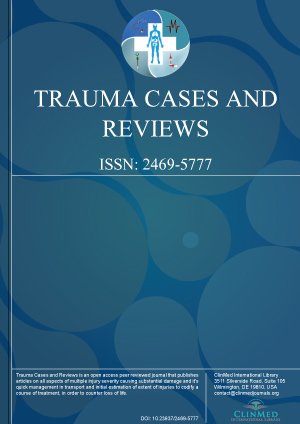Open Access DOI:10.23937/2469-5777/1510100
Spinal Anaesthesia for Hip Fracture in an Elderly Patient with Aortic Dissection and Dilated Cardiomyopathy: A Case Report
Yudhyavir Singh and Balaji Nagarajan
Article Type: Case Report | First Published: 2023/07/07
Aortic dissection is a preventable life-threatening condition, but fatality can be extremely high if not treated timely. And if it is associated with dilated cardiomyopathy, it can be catastrophic for them, and managing this can be an anesthetic nightmare. Here, we present elderly female patients diagnosed with aortic dissection on evaluation with a known case of dilated cardiomyopathy coming for hip fracture fixation. The case was managed with low-dose spinal anaesthesia along with good hemodyn...
Open Access DOI:10.23937/2469-5777/1510099
Using Thromboelastography to Treat Patients with COVID-19-Associated Coagulopathy: A Case Report from the Front Lines
Crista E. Horton, MD, Vincent Athas, MD, Stacey L. Tannenbaum, PhD, Jose Lozada, MD and John Berne, MD
Article Type: Case Report | First Published: 2023/06/18
There has been increasing evidence to support that COVID-19 infection is associated with hypercoagulable complications due to a systemic inflammatory response indirectly activating the coagulation cascade. This phenomenon has been termed, COVID-19-associated coagulopathy. Uniquely, trauma patients are highly susceptible to thromboembolic events. Monitoring for adequate chemical prophylaxis against these events is difficult, especially with superimposed COVID-19 infection....
Open Access DOI:10.23937/2469-5777/1510095
Association between Pre-Hospital Prioritization and Outcome of Injuries from Road Traffic Accidents in Makueni County, Kenya
Anthony Wambua Mathulu, Eliab Seroney Some and Esther M Ndonga
Article Type: Research Article | First Published: November 13, 2021
Globally, about 1.3 million people die each year and others remain disabled for the rest of their life due to road traffic accidents. In Makueni County, 1450 cases and 74 deaths were reported in 2015 and 2016. The purpose of this study was to provide evidence for development of policies and programmes to reduce case-fatality rate and other complications from road traffic accidents in Kenya. The study employed the mixed method approach and crosssectional study design. Universal sampling was appli...
Open Access DOI:10.23937/2469-5777/1510094
Cutting Monopolar Needle Electrode of Electrosurgery, a Safe Tool for Skin Incision in Neurosurgery
Krishan Kumar Sharma and Asgar Ali
Article Type: Commentary | First Published: September 30, 2021
In ancient time heat was used to treat wounds. Now a days electrosurgery unit (ESU) is an important part of operation theatre equipments utilized by almost every surgeon. Electrocautery and diathermy are the term used by many operations theatre medical and paramedical persons including surgeons for electrosurgery. They altogether are three different things. Cutting monopolar needle electrode of electrosurgery is a safe tool for skin incision in neurosurgery but hardly very few surgeons are utili...
Open Access DOI:10.23937/2469-5777/1510093
Usefulness of Magnetic Resonance Imaging in Diagnostic Unstable Fracture of the Lumbar Spine
J Miguel Rodríguez Solera and Ana María Cerván de la Haba
Article Type: Case Report | First Published: September 06, 2021
Most vertebral fractures are properly diagnosed by a simple radiography and a computed tomography (CT), but sometimes this type of preoperative study is insufficient to diagnose an inestable spine lesion. We report a case of 19-years-old man who was brought to our Hospital after a bicycle accident. He had dorsolumbar pain, disability and anormal neurological examination. An X-ray and spine computerized tomography (CT) scan was performed and diagnosed a fracture at second vertebra lumbar. An unst...
Open Access DOI:10.23937/2469-5777/1510092
Heterotopic Ossification of the Triceps Muscle after Internal Fixation of Proximal Ulna Fracture: A Case Report
Chang-Song Mun, Tae-Song So and Chol-Ho Jang
Article Type: Case Report | First Published: September 04, 2021
Olecranon fractures comprise approximately 10% of all fractures around the elbow. They vary in their complexity from relatively straightforward transverse fractures to comminuted and unstable configurations. As in other articular fractures, the aims of treatment, as defined by AO group, are to restore the articular surface, achieve absolute stability of the fracture, and commence early active motion, and, finally, the restoration of function without pain. This is only possible with ORIF (open re...
Open Access DOI:10.23937/2469-5777/1510091
Olecranon Fractures - Review of Treatment and Complications
Henrique Sousa, Ricardo Oliveira, Moisés Ventura, Renato Ramos, Rita Grazina and Andreia Ferreira
Article Type: Review Article | First Published: July 25, 2021
Olecranon fractures are common upper extremity fractures usually subject to surgical fixation. Several options exist for olecranon fracture treatment, tension band, plating, intramedullary nail and fragment excision with triceps advancement are the most used but no technique is suitable for the management of all olecranon fractures and each one is associated with more or less prevalence of the most common complications, namely loss of motion, nonunion, malunion, infection, wound dehiscence, inst...

